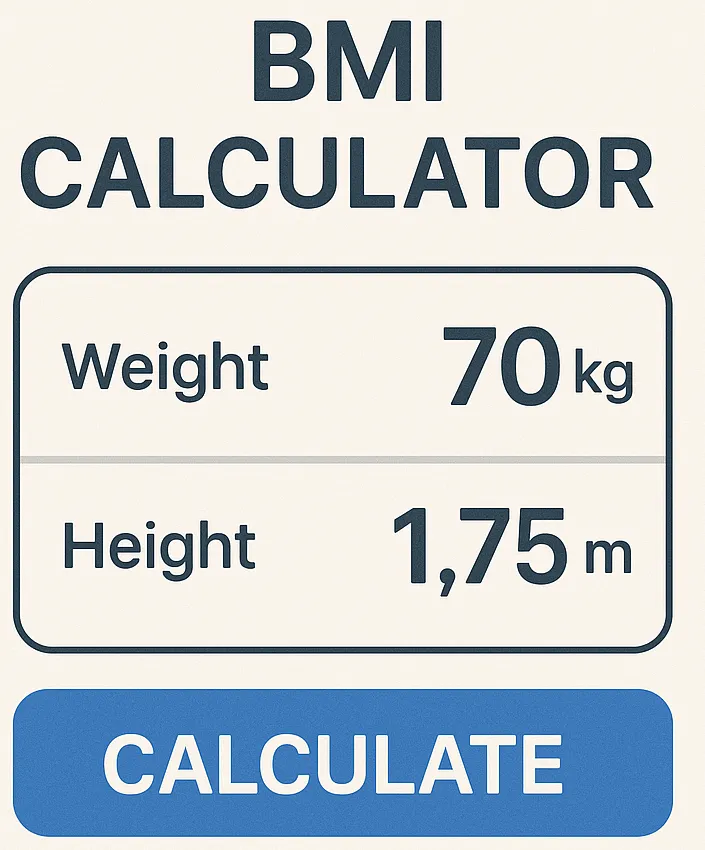What is BMI?
Body Mass Index (BMI) is a numerical value calculated from your weight and height that provides a reliable indicator of body fatness for most people. It is used to screen for weight categories that may lead to health problems.

BMI is a simple, inexpensive, and non-invasive method to assess whether an individual has a healthy body weight for their height. While it doesn't measure body fat directly, research has shown that BMI correlates with more direct measures of body fat.
BMI Formula: BMI = weight (kg) / (height (m))² or BMI = (weight (lbs) × 703) / (height (in))²
Why Calculate Your BMI?
Knowing your BMI can help you and your healthcare provider assess your health risks:
Health Assessment
Identifies potential weight-related health risks
Disease Prevention
Helps prevent obesity-related conditions
Fitness Tracking
Monitors progress in weight management programs
Medical Screening
Used by doctors to identify potential health issues
Goal Setting
Helps establish healthy weight goals
Research Tool
Used in population health studies
BMI Categories for Adults
The World Health Organization (WHO) defines these standard BMI categories:
Below 18.5
May indicate malnutrition, eating disorder, or other health problems
18.5 - 24.9
Healthy weight range with lowest disease risk
25 - 29.9
Increased risk for developing health problems
30 - 34.9
High risk for heart disease, diabetes, and other conditions
35 - 39.9
Very high risk for serious health conditions
40 and above
Extremely high risk with severe obesity-related health problems
BMI for Children and Teens
BMI interpretation for children and teens considers age and gender:
- Percentile System: Children's BMI is compared to growth charts for their age and gender
- Underweight: Below 5th percentile
- Healthy Weight: 5th to 85th percentile
- Overweight: 85th to 95th percentile
- Obese: Above 95th percentile
- Growth Patterns: Pediatricians track BMI changes over time
- Different Standards: Children's BMI changes naturally as they grow
Limitations of BMI
While BMI is a useful screening tool, it has some limitations:
Muscle Mass
May overestimate body fat in athletes with high muscle mass
Age Factors
May underestimate body fat in older adults who have lost muscle
Body Composition
Doesn't distinguish between fat, muscle, and bone mass
Ethnic Variations
Some ethnic groups may have different health risks at the same BMI
Pregnancy
Not appropriate for pregnant women
Height Extremes
May be less accurate for very tall or very short individuals
Frequently Asked Questions (FAQ)
BMI is a useful screening tool but not a diagnostic of body fatness or health. It should be used along with other assessments like waist circumference, diet, physical activity, and family history.
Children's body fat changes with age and differs between boys and girls, so their BMI is compared to growth charts for their specific age and gender.
For adults over 65, a BMI between 23 and 29 may be healthier than the standard range, as slightly higher BMI can protect against osteoporosis.
Yes, athletes with high muscle mass may have a high BMI that classifies them as overweight despite having low body fat.
For most adults, checking every 3-6 months is sufficient unless you're actively trying to lose or gain weight.
Waist-to-hip ratio, body fat percentage measurements, and comprehensive health assessments provide more complete pictures of health.
Keywords
Our BMI Calculator is optimized for these search terms:
- BMI calculator
- body mass index calculator
- BMI chart
- healthy weight calculator
- weight status tool
- BMI formula
- adult BMI calculator
- child BMI calculator
- BMI calculator kg and cm
- calculate BMI online
- BMI calculator for women
- BMI calculator for men
- teen BMI calculator
- BMI calculator with interpretation
- free BMI calculator